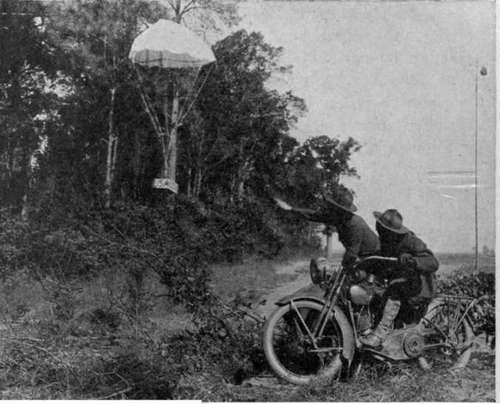V. Methods Of Handling Plates, Films And Papers. Chapter XXIII. The Developing And Drying Of Plates And Films. Field Requirements
Description
This section is from the book "Airplane Photography", by Herbert E. Ives. Also available from Amazon: Airplane photography.
V. Methods Of Handling Plates, Films And Papers. Chapter XXIII. The Developing And Drying Of Plates And Films. Field Requirements
Developing, fixing, drying and printing in the field demand simple and convenient apparatus that may be carried about and installed with the least amount of labor. On top of these requirements military needs impose others that are more difficult. Speed is, on occasion, imperative. A print may be required within a few minutes after landing, and many thousands within a few hours. Quantity production must be achieved under the most primitive conditions. Nothing, in fact, shows the calibre of the photographic officer better than his choice of workplaces as the army moves forward. Ingenuity and practical judgment are at a premium. Cellars, stables, dog kennels, or huts hastily built from packing cases, must be equipped and in working order over night. Alt the facilities offered by a great city are urgently needed-ówater, electric light, power for driving fansóbut must be dispensed with if the photographic section is to be convenient to the airdrome, whose portable hangars are most apt to be pitched in the* open country. Water must be carried, electricity generated, and to the photographic problem is added the military one of concealment and protection. Dugouts and bomb proofs must be built for supplies, and "funk holes" for the men. Entire underground emergency extensions have sometimes been built in stations occupied for extended periods, for airdromes are a favorite bombing target.
For getting the exposed plates to the photo section, messengers, on motorcycles if possible, are employed. In some cases, where hangars and photographic hut are forced to be widely separated, recourse has been had to parachutes (Fig. 112), a device also employed to distribute prints to infantry during an advance.
For warfare of movement, especially in sparsely settled or devastated country, where cellars are unavailable, the dark room must be taken along. Motor trucks and trailers (Figs. 113, 114, 115), the former for hauling supplies and electric light generating plant, the latter fitted as a complete developing and printing laboratory, form the headquarters of each photographic section in the field. Usually altogether too small for the amount of work required, they were extended by tents and lean-to's, or ingeniously used as a nucleus for the organization of the favored stable or cellar.

Fig. 112. - Receiving pictures from plane by parachute.
Continue to:
Tags
camera, lens, airplane, aerial, film, exposure, photography, maps, birdseye
